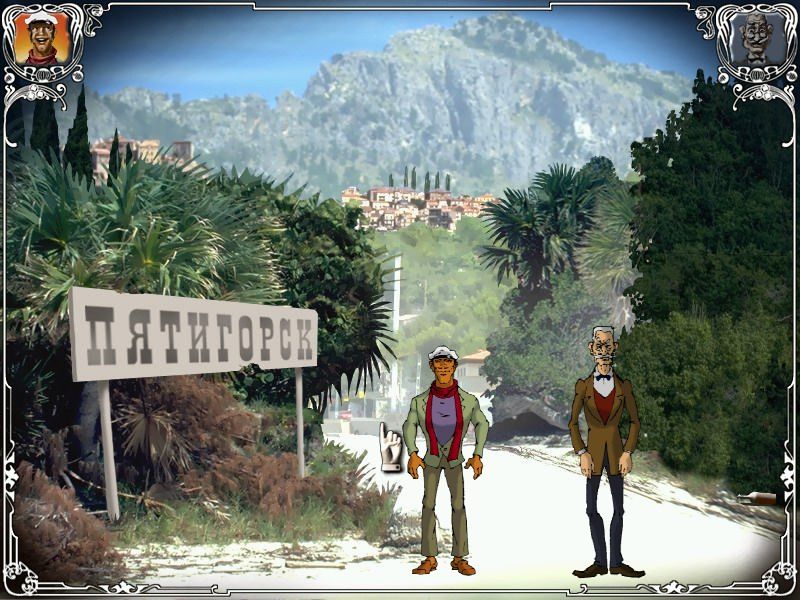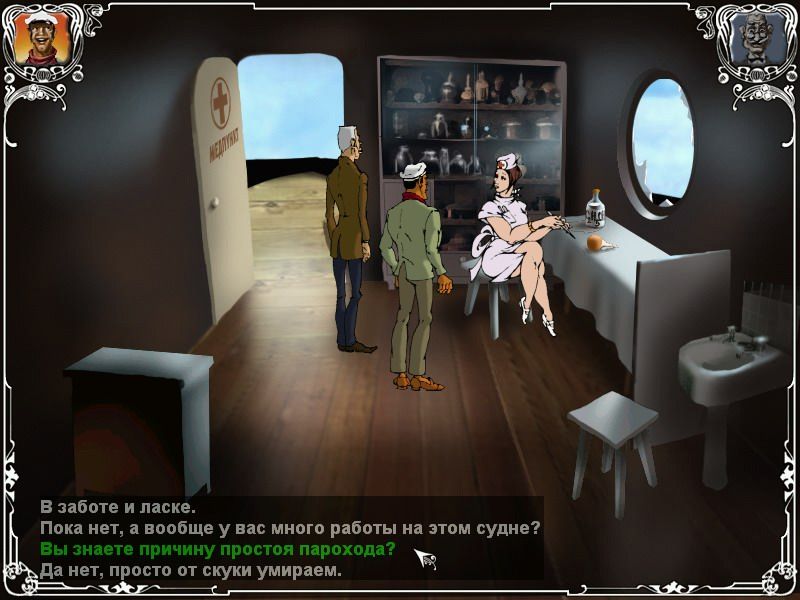Retro Replay Review
Gameplay
Dvenadtsat’ Stuljev embraces the classic point-and-click adventure formula, delivering hands-on control over Vorobyaninov and Ostap Bender as they sift through clues and interrogate colorful NPCs. The cursor-based interface is intuitive, with context-sensitive actions that let you examine, talk, pick up, or use objects without tedious menu navigation. Seasons, times of day, and evolving cityscapes lend a dynamic feel to exploration, encouraging backtracking and creative problem solving.
(HEY YOU!! We hope you enjoy! We try not to run ads. So basically, this is a very expensive hobby running this site. Please consider joining us for updates, forums, and more. Network w/ us to make some cash or friends while retro gaming, and you can win some free retro games for posting. Okay, carry on 👍)
Puzzle design strikes a satisfying balance between challenge and accessibility, blending inventory puzzles with witty dialogue puzzles, memory games, and environmental riddles. Clues are often hidden in snippets of period-appropriate signage, overheard conversations, or comical newspaper headlines. Though a few late-game puzzles demand leaps of logic that may frustrate newcomers, an in-game hint system (delivered as tongue-in-cheek telegrams from Bender) helps keep progress smooth without outright hand-holding.
Interaction with companions and bystanders deepens the gameplay loop. Ostap Bender’s sly quips and opportunistic schemes regularly open alternative puzzle solutions, while Vorobyaninov’s exasperation yields unique dialogue paths. You’ll find yourself juggling their abilities—Bender’s charm to sweet-talk, Vorobyaninov’s connections to bribe officials—as you chase rumors about the missing chairs across Soviet towns and country roads.
Graphics
Dvenadtsat’ Stuljev sports a vibrant, hand-drawn aesthetic that evokes cartoonish storybooks of the 1930s. Backgrounds are richly detailed, from the peeling plaster of provincial offices to bustling marketplaces adorned with propaganda posters. Subtle animations—like drifting snow, flapping banners, or the twitch of a street dog’s ear—bring locations to life and ground the characters in a believable, immersive world.
Character portraits and in-scene sprites exhibit expressive gestures and exaggerated features, emphasizing the story’s satirical humor. Vorobyaninov’s perpetually worried brow contrasts nicely with Bender’s cocky grin and jaunty stride. Moments of slapstick—such as a chair collapsing under an overeager investigator—are punctuated by well-timed sound effects and screen shakes, adding a layer of visual comedy akin to classic cartoons.
The game’s user interface stays out of the way, with clean dialogue windows and minimalist inventory bars that preserve screen real estate. Menus employ Cyrillic-inspired typefaces for authenticity, and loading screens feature stylized sketches from the source novel. While not pushing the boundaries of modern 3D engines, the art direction perfectly captures the charm and whimsy central to adventure classics like Curse of Monkey Island.
Story
Rooted in Ilya Ilf and Jevgeny Petrov’s beloved satiric novel, Dvenadtsat’ Stuljev faithfully adapts the core narrative: a fallen aristocrat and a cunning grifter scour Soviet Russia for forty lost chairs, one of which hides a trove of diamonds. This premise cleverly translates into episodic chapters, each set in a distinct locale—gypsy camps, provincial fairs, bureaucratic offices—where comedic mishaps and ideological jabs await.
Writers have expanded side plots and new characters while preserving the spirit of the 1930 setting. Ostap Bender’s barbed commentary on collectivization, queue-line absurdities, and moral flexibility feels both historically resonant and universally funny. Vorobyaninov’s uptight persona provides a steady foil, leading to humorous debates about ethics, greed, and the shifting social order.
Dialogue retains the novel’s razor-sharp wit, with occasional modern touches that clarify cultural references for international audiences. Cutscenes are voiced by actors who capture each character’s unique cadence, and brief text inserts provide helpful background on revolutionary history. Though fans of the original will spot every classic gag, newcomers will appreciate a coherent, well-paced storyline brimming with memorable set pieces and unexpected twists.
Overall Experience
Dvenadtsat’ Stuljev shines as a loving homage to both its literary roots and the golden age of point-and-click adventures. Its blend of satirical storytelling, engaging puzzles, and cartoon-style graphics creates a warm, inviting atmosphere that rewards careful exploration and curious minds. Whether you’re a history buff, a comedy enthusiast, or a fan of narrative-driven gameplay, this title offers hours of entertaining discovery.
Minor performance hiccups emerge on lower-end hardware—rare frame drops in dense scenes and occasional audio stutters during rapid character exchanges—but patches are already addressing these issues. The pacing never drags, thanks to varied environments and a steady drip of new mechanics and NPC interactions that keep each chapter feeling fresh.
Ultimately, Dvenadtsat’ Stuljev stands out as an accessible yet richly layered adventure, ideal for players seeking a humor-laced journey through early Soviet life. Its seamless blend of classic gameplay conventions with period-specific charm makes it a compelling pick for anyone eager to solve intricate puzzles while soaking up the heady atmosphere of revolutionary Russia.
 Retro Replay Retro Replay gaming reviews, news, emulation, geek stuff and more!
Retro Replay Retro Replay gaming reviews, news, emulation, geek stuff and more!









Reviews
There are no reviews yet.